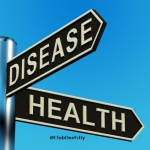 What do we Mean by ‘Physical Activity’?
What do we Mean by ‘Physical Activity’?
Physical activity is defined as any bodily movement produced by skeletal muscles that results in energy expenditure.
This includes, but is not limited to, activities like walking, gardening, riding a bike, dancing, working out in a gym, playing tennis or soccer – just to name a few. The terms and definitions relating to physical activity that are used in Club One Fifty can be found here.
Why Focus on Physical Activity in Club One Fifty?
Club One Fifty has a mission of helping our members to live a long and healthy life (see our mission). In view of this mission, why do we include physical activities?
Well, the scientific evidence is today overwhelming that physical activity provides a wide spectrum of health benefits, including reductions in risk for a variety of diseases and improvements in functional ability. [1]
 Coronary heart disease was the first condition whose occurrence was shown to be reduced by regular physical activity [2]. Subsequently, the list of health benefits attributable to physical activity has grown significantly. A recent report ‘Physical Activity Guidelines Advisory Committee Report’ [1] concludes that strong scientific evidence indicates that physical activity reduces the risk of:
Coronary heart disease was the first condition whose occurrence was shown to be reduced by regular physical activity [2]. Subsequently, the list of health benefits attributable to physical activity has grown significantly. A recent report ‘Physical Activity Guidelines Advisory Committee Report’ [1] concludes that strong scientific evidence indicates that physical activity reduces the risk of:
- Early death,
- Coronary heart disease,
- Stroke,
- High blood pressure, and the list goes on,
- Type 2 diabetes, breast and colon cancer, excessive weight gain, injurious falls, depression, and loss of cognitive function. Moderately strong scientific evidence demonstrates that physical activity maintains functional ability in older adults, helps maintain weight loss, improves sleep quality, and reduces the risk of hip fracture and osteoporosis.
In summary, physical activity is very important for a long and healthy life.
Mechanisms Behind the Benefits
The mechanisms by which regular physical activity induces these benefits lie in the acute and chronic physiologic changes it causes. Voluntary contraction of skeletal muscles requires the confluence of raw materials, e.g. oxygen, glucose and fat, for releasing energy and the metabolic and neurologic coordination to use the resources effectively to cause bodily movement. The specific physiologic adaptations depend on the type of activity performed. [3]
What Type of Physical Activity do Club One Fifty Promote?
We encourage all types of physical activities – be it running, gardening, working out in the gym, hiking, doing sports like tennis or basketball. Some level of activity is better than no activity. The belief that a threshold of activity must be achieved before benefits accrue is common but inaccurate [3]. More activity is generally better than less.
 Specifically, the type of physical activity that we promote and present is workouts and exercises around what is known as calisthenics or bodyweight training. This type of training uses our own body as the main equipment and is suitable for all ages – from kids to persons that well have passed 100 years of age. The workouts are easily adapted to the current individual level of physical fitness.
Specifically, the type of physical activity that we promote and present is workouts and exercises around what is known as calisthenics or bodyweight training. This type of training uses our own body as the main equipment and is suitable for all ages – from kids to persons that well have passed 100 years of age. The workouts are easily adapted to the current individual level of physical fitness.
Our members have access to a workout archive with workouts that typically can be performed:
- Whenever it is convenient, in the morning or in the evening.
- Wherever you are – in your home or in a hotel room when out travelling.
Besides the regular workouts, a number of sporting events are arranged for our members every year, e.g. the Golf Trophy and Mixed Invitational in Tennis.
Click here for more details about physical activity in Club One Fifty.
Training Programmes
There are a number of ready-made training programmes available for our members. You could download a programme and be up and exercising within a few minutes. After completing a programme we can guarantee that you are in the best shape of your life!
A member that has shown great appreciation of the membership in Club One Fifty do also receive an individual Physical Activity Programme. This programme is based on your personal situation taking into account your personal goals, age, previous and current physical activity, fitness preferences and other factors.
References, Sources
- Physical Activity Guidelines Advisory Committee Report. Washington, DC: US Department of Health.
- Physical Activity and Cardiovascular Health. MS Fox, JS Skinner. American Journal of Cardiology.
- Physical Activity for Health: What Kind? How Much? How Intense? On Top Of What? Kenneth E. Powell, Amanda E. Paluch and Steven N. Blair.
Physical Activity and Health. The Evidence Explained. Adrienne E. Hardman and David J. Stensel.